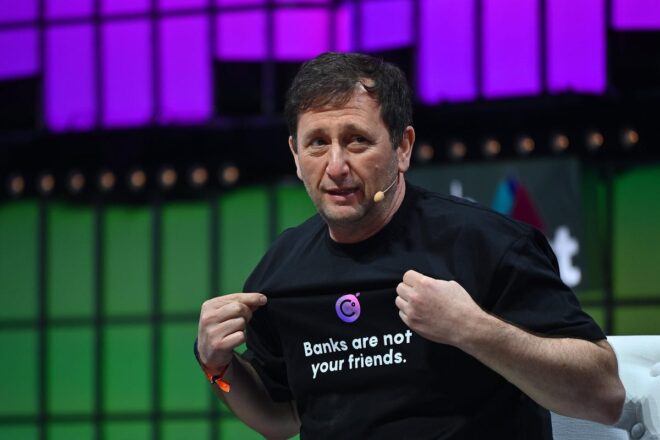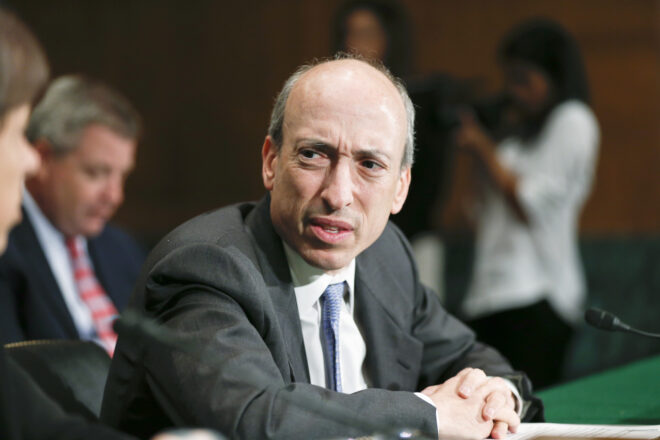2022 in Review: the Top 10 Crypto Villains of the Year
Some of crypto’s favorite “heroes” were exposed as villains in 2022.

Key Takeaways
- Several ego-driven crypto personalities suffered huge falls from grace in 2022.
- Terra's failure exposed some of the crypto ecosystem's biggest villains.
- Policymakers and scammers also harmed the space this year.
Share this article
SBF, Kwon, 3AC, and more: 2022 was a packed year for crypto villains.
The Crypto Villains of the Year
The Crypto Briefing editorial team puts a lot of thought into our end-of-year lists. There are often disagreements on who should feature and we end up spending a lot of time going back and forth on ideas until the list gets finalized. This year’s top 10 crypto villains list was the hardest one we’ve ever put together.
After a year like the one we’ve just had, it was an almost impossible task to pick out just 10 villains. There are obvious candidates like Sam Bankman-Fried and his friends who helped him commit the biggest fraud of the century at FTX and Alameda Research. While mainstream media outlets have hardly lobbed softballs at the entrepreneur now known as “Scam Bankrun-Fraud,” we felt it was important to call out him and everyone else who was involved in the scandal, which is why they jointly take the top spot for 2022.
In another update that should surprise no one, Su Zhu is back alongside Kyle Davies following Three Arrows Capital’s implosion, and Do Kwon, arguably the person responsible for the most damage in crypto this year, also features.
The biggest twist to this year’s list is the heavy skew toward former “heroes” in the space. There was a time when guys like SBF and Kwon were idolized, which raises questions about how the crypto community should identify the next villains when they arrive (because more will arrive).
Beyond the obvious names, we settled on a few evil types who seemed to get away with making bank at the community’s expense, policymakers who went heavy on anti-crypto rhetoric, and a couple of good old-fashioned scammers.
As ever, there were plenty of hackers and rug pullers that went unmentioned, but that doesn’t negate the hurt they caused for their own financial gain this year. We also excluded groups and institutions, which meant omitting the likes of Lazarus Group (for the $550 million Ronin Network attack and other cyber thefts) and the U.S. Treasury Department (for using Lazarus Group’s actions as an excuse to sanction Tornado Cash).
All in all, it’s the biggest list of con artists we’ve ever put together, and we hope that at least some of the candidates are served their just deserts by the end of 2023. Behold, and take thorough notes on the red flags to look out for on the next market cycle.
Sam Bankman-Fried and Friends

The problem with covering the FTX scandal here is that there are still so many unknowns, and we don’t know what to believe—especially when Sam Bankman-Fried’s own comments have amounted to cryptic tweets and leaked apology notes that read about as coherently as you’d expect from someone who was allegedly caning stimulants on the regular.
But putting aside the reports of amphetamine abuse, orgies, luxury property acquisitions, and suspicious donations to political figures, there’s one reason above all else that Bankman-Fried is crypto’s Public Enemy Number One: he stole $10 billion of FTX customers’ money.
While FTX has only recently declared bankruptcy and legal proceedings are ongoing, we do know that Bankman-Fried secretly siphoned customer funds from FTX to his trading firm Alameda Research as the firm faced insolvency after Terra’s blowup. Twitter messages Bankman-Fried exchanged with a Vox journalist also reveal that Alameda could have been playing with FTX money long before Terra imploded, and just as shockingly, his persona of virtue was a deliberate facade to get anyone he wanted—politicians, media publications, sports personalities, supermodels—onside.
Bankman-Fried made out that he was in this space “to make a global impact for good” (on San Francisco billboards adorning his face and scruffy, unkempt hair, no less), but all of the recent revelations have cast doubt on that claim. While we can’t conclusively say whether Bankman-Fried had good intentions or was evil from the outset, we don’t think it’s a stretch to say that he’s always had a big ego, and that led to his astonishing fall from grace.
Either way, it’s the sheer deception that makes Bankman-Fried our number one villain of the year. This was a guy who sat in front of Congress warning against the risks of opaque crypto practices knowing that he’d stolen from his customers with the same practices. Almost everyone bought into his con, which has added hurt on top of the staggering financial losses the community has suffered from FTX’s insolvency.
It’s important to note that Bankman-Fried, a talented son of two Stanford Law School professors, grew up privileged before he turned to crypto and effective altruism. This might explain why, against all odds, he’s still walking free in The Bahamas, and mainstream outlets like The New York Times and The Wall Street Journal have handed him clear passes in their recent coverage.
When we talk about Bankman-Fried, we also have to mention the likes of Caroline Ellison, Sam Trabucco, Gary Wang, Constance Wang, and Nishad Singh. Though it’s unclear how much involvement each of them had in FTX’s fraudulent practices, it’s known that they were all part of the inner circle that Bankman-Fried confided in as he presided over his empire.
When we were putting together our list, one member of our editorial team said that “Bankman-Fried is to crypto what Palpatine is to Star Wars.” In other words, he’s as despicable as it gets, and those who enabled his actions aren’t much better. We sincerely hope that justice is served in 2023. Chris Williams
Do Kwon

Until about a month ago, there was only one contender for our number-one villain spot: Do Kwon. But while the failed Korean entrepreneur probably isn’t as terrible as Sam Bankman-Fried, he’s indisputably responsible for colossal damage and suffering that will hold the crypto ecosystem back for years.
Similar to Bankman-Fried, Kwon was a whizz kid who became a superstar almost overnight. On many occasions, he made it obvious that he didn’t know how to handle the fame. As Terra soared to new high after new high and his paper riches grew, he started calling himself the “Master of Stablecoin” and dismissing others who hadn’t happened to invent a flawed money-printing algorithmic stablecoin as “poor.” Kwon enjoyed the limelight but he had thin skin; he proved that when he unleashed attacks like that “your size is not size” tweet that became the stuff of Crypto Twitter legend. There was also a laughable lawsuit threat that Terraform Labs sent to Crypto Briefing after we published a satirical warning that Terra would fail near LUNA’s top on April Fools’ Day, but that ended up looking just as stupid as his hubris-filled tweets once Terra suffered its inevitable demise. Neither Kwon nor his lawyers have responded to any of our messages requesting comments on Terra’s implosion.
It should go without saying that Kwon is one of crypto’s biggest villains ever, especially given the destruction that Terra’s failure has caused. Kwon has suggested that Terra was a market failure, as if Terraform Labs’ efforts to brand UST as a “stablecoin” were legit and above board. He’s also maintained that LFG’s reserves went into saving UST, denying allegations the funds were moved elsewhere.
While we can’t prove anything and he’s evaded most difficult questions following the death spiral, we suspect that Kwon had a feeling that Terra would fail, which might be why he committed to accumulating a Bitcoin reserve fund through the Luna Foundation Guard. If he was aware of Terra’s destiny, which is plausible given his ties to Basis Cash, that only makes his actions more deplorable.
Terra’s collapse led to huge financial losses and, in the worst cases, suicides, but Kwon has shown little remorse. He tried to relaunch Terra even after repeated calls to disappear from crypto forever and has made it clear that he still loves attention, appearing on Crypto Twitter and podcasts once Bankman-Fried took his place on the villain top spot.
Kwon made it onto Interpol’s red list in September, but he insists that he’s not “on the run.” We’re not sure what else fleeing your country of residence and refusing to reveal your location could be called, but then nothing he’s said this year should be taken too seriously.
Kwon did have one pearl of wisdom, though. In one interview, he infamously warned that “the failure of UST is equivalent to the failure of crypto itself.” After the chaos that Terra caused this year, his message proved to be more on-point than anyone of us dared to imagine. Chris Williams
Su Zhu and Kyle Davies

In the laundry list of disgraced founders that met their own undoing this year, perhaps none were as revered as Su Zhu and, by extension, his partner Kyle Davies. Davies may have been complicit in what turned out to be yet another multibillion-dollar scam, but it was Zhu, with his mysterious persona and cryptic, zen-like tweets, who captured the imagination and inspired disciples.
Zhu and Davies launched Three Arrows Capital in 2012 and found success in forex trading before pivoting to crypto in 2018. Zhu famously called the bottom of 2018 crypto winter after watching Bitcoin’s staggering run-up the previous year. “We will pump off the bottom extremely quickly, leaving most sideline investors stuck in fiat,” he tweeted on December 21, 2018. Bitcoin was trading at $4,000 at the time, while Ethereum had just touched double digits.
By 2021, the market hailed Zhu and Davies as geniuses, pontificating wisdom and walking the earth as the living embodiment of success. 3AC’s main shill was that crypto had crossed the threshold into “the Supercycle,” a thesis that claimed crypto had become immune to sharp drawdowns owing to increasing mainstream interest in the space. The jargon is dense but the idea isn’t—Zhu and Davies simply convinced a lot of smart, rich, successful people that the price of Bitcoin would never correct again in exactly the way it always had before.
Not only that, but everyone in the crypto business was getting in on 3AC’s action. When the market boomed throughout 2021, so did 3AC and everyone along for the ride.
But we all know what happened next. When prices declined, an entire ecosystem that depended on them consistently trending up forever fell in on itself. The Supercycle theory was “regrettably wrong,” Zhu later said on Twitter, probably against the wishes of his lawyers. “Regrettable” is one word for it; “stupidly irresponsible” might be another. It’s one thing to have an exuberantly bullish stance on something; it’s another thing to bet everything on it, especially if that includes other people’s money.
And when you start to trace whose money was whose, the result is a grotesque web of incestuous, high-risk, leveraged trading among a familiar cast of unruly characters, with 3AC right in the got-dang middle of it.
Soon after it became clear that 3AC was bust, Zhu and Davies effectively disappeared—Zhu stopped tweeting, they stopped turning up to their office, and even stopped answering the phone. We scarcely heard a word from either of them, save for a Bloomberg interview in which the pair tried to downplay antics like their plans to spaff $50 million on a Dogecoin-themed superyacht.
They’ve since resurfaced on Twitter to goad Sam Bankman-Fried following FTX’s collapse, with some speculating that they could be looking to raise a new fund. While they are still missing IRL, Davies has been spouting disingenuous platitudes and insisting they have “a story to tell,” as if this were a primetime Oprah special and not a multi-billion-dollar fraud.
Zhu, meanwhile, has been surfing. Jacob Oliver
Alex Mashinsky

Alex Mashinsky is the former CEO of Celsius, a lending firm that froze customer withdrawals due to “extreme market conditions” in June then filed for bankruptcy weeks later. Celsius was one of several dominoes to fall following Terra and Three Arrows Capital’s blowups, but the company’s bankruptcy filings revealed that Mashinsky was to blame for many of its troubles.
By selling undercollateralized loans and taking enormous risk, Celsius ended up with a ten-figure hole in its balance sheet—a hole that Mashinsky tried to shore up by directionally trading Bitcoin with customer funds, losing even more in the process. Another of Mashinsky’s brilliant ideas was to hold onto Celsius client funds and wait for up only mode to resume in the market to pay them back, but by then he was no longer in control. He also proposed for the company to rebrand to “Kelvin” and focus on offering custodial services for crypto users, but that plan had no legs either. He resigned as CEO in September.
It was later revealed that Mashinsky and other executives had withdrawn millions of dollars from Celsius before locking out their customers, another bombshell revelation that should surely guarantee his time behind bars.
Mashinsky became famous for peddling the slogan “Banks are not your friends” on Celsius-branded merchandise. Similar to other villains on this year’s list, he rose to prominence by making out that he was a Robin Hood figure, but in reality he was closer to Prince John—a greedy, deceitful fool who bet everything and lost.
Considering Mashinsky’s liberal attitude toward handling client funds, it’s a miracle that he’s still walking free. And maybe he knows this all too well: two weeks after Celsius froze customer funds, the company had to issue a statement denying that Mashinsky had tried to flee the United States. Tom Carreras
Avraham Eisenberg

As far as villains go, Avraham Eisenberg is a “lawful evil” operator. A self-described “applied game theorist,” Eisenberg rose to prominence when he announced that he was responsible for the $100 million exploit on Solana DeFi protocol Mango Markets in October.
Eisenberg took advantage of the low liquidity levels on Solana to manipulate the value of Mango Markets’ MNGO token. After artificially raising MNGO’s price, he used it as collateral to withdraw assets from the protocol. This left Mango Markets with $100 million of “bad debt” to users that had deposited assets into the protocol.
While most onlookers would say that Eisenberg had clearly exploited a vulnerable DeFi protocol, he unapologetically referred to the act as “a highly profitable trading strategy.” Predictably, this ruffled feathers in the crypto community. Some onlookers maintain that Eisenberg used the protocol as intended, so his exploit was fair game. Others are less convinced.
Eisenberg’s Mango Markets attack later inspired a similar $1 million exploit on Solend; Eisenberg denied any involvement in the incident in a message to Crypto Briefing. DeFi favorite Aave was also hit soon after the Solana DeFi attacks when someone manipulated the price of Curve Finance’s CRV token; however, this exploit appeared to backfire and lost the perpetrator money. Eisenberg is widely believed to be the Aave attacker, but he told Crypto Briefing he was not responsible for any “manipulating” on CRV’s price. Still, he didn’t hesitate to capitalize on the incident over on Crypto Twitter. “Couple more liquidations then up only,” he joked in a desperate bid for likes and retweets following the incident, referencing a legendary meme from Three Arrows co-founder Kyle Davies.
While Eisenberg has wreaked havoc in DeFi and left behind a path of destruction, there’s a fair argument that he’s actually a villain the crypto industry needs. If DeFi is to scale, it needs to be failproof, and people like Eisenberg are playing a part in making it safer by stress testing protocols with an abundance of capital and knack for sniffing out vulnerabilities. Tim Craig
Michael Patryn AKA 0xSifu

Wonderland Money was a breakout star of the 2021 bull run. Founded by Daniele Sestagalli with a treasury managed by pseudonymous crypto character 0xSifu, the Avalanche-based DeFi project was widely regarded as the only successful OlympusDAO fork. However, everything came crashing down in January 2022 when the crypto community discovered 0xSifu was QuadrigaCX’s criminal co-founder Michael Patryn. QuadrigaCX became one of crypto’s most controversial exchanges after losing $200 million in customer funds. Patryn had already been convicted of multiple crimes before his involvement in the company, including identity theft and conspiracy to commit credit card fraud. So it’s quite understandable that TIME holders became concerned about leaving him in charge of the $700 million that, at the time, constituted the Wonderland treasury.
Sestagalli’s reputation never recovered after it was revealed that he had kept 0xSifu’s identity under wraps. Neither did 0xSifu’s, but that didn’t stop the former convict from staying active on Crypto Twitter and mocking at the community’s diatribes against him. More than anyone else on our list, 0xSifu has leaned into his “villain” persona, regularly posting memes warning people not to trust him with their funds. He also launched a worthless meme token and forced through a Wonderland proposal to allocate $25 million into it. Did 0xSifu’s brazenness serve as inspiration for Do Kwon and other crypto villains to unapologetically stick around after they fell from grace? If so, they still have much to learn from the master. Tom Carreras
Martin “Syber” van Blerk

If you read Crypto Briefing’s recent Heroes of the Year list, you’ll have seen Pixelmon’s zombie turtle Kevin make a somewhat unconventional appearance. Since we’ve acknowledged how one poorly-rendered sprite helped people find humor in one of the biggest NFT rug pulls in history, it’s only right that its perpetrator holds a spot on our villains list.
Martin van Blerk started the Pixelmon project under the pseudonym “Syber” in late 2021. The project talked a good talk and lured in thousands of speculators despite its eye-watering 3 ETH mint price. However, once the Pixelmon euphoria died down, many who had aped in had to face reality.
It turned out that Pixelmon’s marketing was all a ruse to trick overly optimistic minters into handing over their ETH. The art was copied, the execution sucked, and communication was patchy. As pressure mounted, van Blerk revealed his identity, and it became apparent that the NFT community had just handed over millions to an inexperienced child who was in way over his head.
Some have since defended van Blerk and blamed minters for rushing into Pixelmon without doing proper research. But as far as we’re concerned, he knew what he was doing, even if he didn’t expect his scam to be as successful as it was. To be fair to van Blerk, he has since used the $71.4 million raised to hire a proper team of developers and artists, and Pixelmon is starting to look like it could become a half-decent game—when it eventually launches. But that’s probably not much consolation for those who were tricked into buying into the project under false pretenses. Tim Craig
Justin Sun

TRON founder Justin Sun has always been a controversial figure in crypto, but this year he took his business machinations to a new level by capitalizing on multiple tragic events. Whenever there has been fear, uncertainty, or a loss of user funds, Sun has come out of the woodwork to peddle schemes and profit from the chaos.
In May, he doubled down on plans for his USDD algorithmic stablecoin days after Terra’s UST collapsed in a whirlwind death spiral. Sun watched as droves of investors lost their life savings betting on Terra and its cheerleader Do Kwon, but that wasn’t enough to dissuade him from promoting his own dollar-pegged asset, promising “zero-risk” yields of up to 30%, days after the collapse. By all accounts, Sun saw Terra’s downfall not as a warning but as an opportunity to take advantage of beleaguered investors burned by a competitor.
Later in the year, Sun resurfaced to advertise his allegiance with Chandler Guo’s plan to fork Ethereum after the network’s “Merge” to Proof-of-Stake. While most onlookers saw the fork for what it was—an opportunistic cash grab—Sun was relentless in his attempts to profit from the Merge hype.
However, Sun’s most egregious plot targeted those with funds trapped on FTX after the exchange declared bankruptcy on November 11. TRON provided a “liquidity provision” to FTX, facilitating withdrawals for several Sun-affiliated tokens. As there were so many FTX users trying to get funds off the exchange, these tokens’ prices skyrocketed. Users paid huge premiums on tokens like TRX and HT, allowing TRON to dump them at jacked-up prices and pocket the difference. In this way, Sun directly profited from the awful situation FTX left its customers in. Tim Craig
Gary Gensler

In a year marked by a sharp uptick in regulatory action from the U.S. government, it was difficult to sort through which agency was this year’s most nefarious—between the CFTC’s crackdown on DAOs to the Treasury unilaterally outlawing Tornado Cash, it’s hard to limit ourselves to just one for this list.
But who are we kidding? Everyone knows this year’s policy villain is Gary Gensler.
Yes, the SEC chair himself still stands tall as the crypto community’s most-reviled regulator in Washington. Recently Gensler has drawn particular ire for his alleged connections to FTX and its officers. Gensler was a colleague of Caroline Ellison’s father, Glenn Ellison, who chaired the economics department at MIT when Gensler was on the faculty there. Caroline, who was eventually made CEO of Alameda Research, has a long (and reportedly romantic) history with Bankman-Fried, dating back to their time working together at Jane Street. It’s a small world, after all.
While it’s clear that there is at least some personal acquaintanceship between these characters, there is not yet evidence of anything we could call criminal conspiracy. It’s true that Gensler met with Sam Bankman-Fried in March of this year, but little is known about the content of the conversation. Fox Business reported that Gensler filled the meeting with a 45-minute lecture on U.S. securities laws without hearing out Bankman-Fried’s concerns, which frankly rings more true to my ears than the idea of any intentional collusion, as some are suggesting. It was also reported that Gensler’s pontifications included a warning about keeping Alameda and FTX strictly separate, which, if true, makes Bankman-Fried look even worse, not Gensler.
Still, there has hardly been such a consistent, omnipresent boogeyman looming over the space as Gary Gensler, who has trained his terrible gaze on the crypto industry like the Eye of Sauron. And yet, the fact remains that Sam Bankman-Fried, who was galavanting around Capitol Hill, snapping pics with lawmakers and taking meetings with the SEC Chair himself, orchestrated what seems to have been the largest (and arguably least competent) fraud in the history of the industry—and he did it right under Gensler’s very nose.
There are real questions about why Gensler, notorious for breathing down the neck of the crypto community, missed the wolf in sheep’s clothing parading around his stomping grounds. It hints at either ignorance, incompetence, or complicity, and it’s hard to say which of the three would be the worst. Jacob Oliver
Justin Trudeau

Canadian Prime Minister Justin Trudeau angered the crypto community in February for his draconian handling of the “Freedom Convoy” protests. When Canadian truckers blocked the streets of Ottawa in protest against COVID-19 vaccine mandates and restrictions, Trudeau responded by invoking the Canadian Emergencies Act. The decision granted the Canadian government power to freeze the bank accounts of demonstrators (and of any individuals supporting the protests through donations) without providing them recourse. The truckers countered by switching to Bitcoin and other crypto services; this led the government to blacklist at least 34 crypto wallets connected to the Freedom Convoy. The decision provoked a strong backlash, with Coinbase CEO Brian Armstrong and Kraken CEO Jesse Powell urging their respective customers to use self-custodial wallets in order to protect themselves. The Ontario Securities Commission responded by reporting Armstrong and Powell’s tweets to law enforcement.
Trudeau’s decision to weaponize financial institutions against ordinary Canadians was a shocking display of centralized power. It also showed that citizens of Western democracies are not guaranteed access to their banking services. Bitcoin was created precisely to offer a permissionless, censorship-resistant alternative to such systems. In a twisted way, we should be praising Trudeau for demonstrating the need for decentralized financial tools; he also implicitly proved the resiliency of such technologies—while the Canadian government was able to forbid companies from accepting funds from specific wallets, it couldn’t freeze crypto funds outright. Tom Carreras
Editor’s note: This feature has been amended to include comments from Avraham Eisenberg. A previous version stated that he had attacked Solend and manipulated CRV’s token price, but he denied those claims.
Disclosure: At the time of writing, some authors of this feature owned BTC, ETH, SOL, AAVE, CRV, and several other crypto assets.
Share this article
